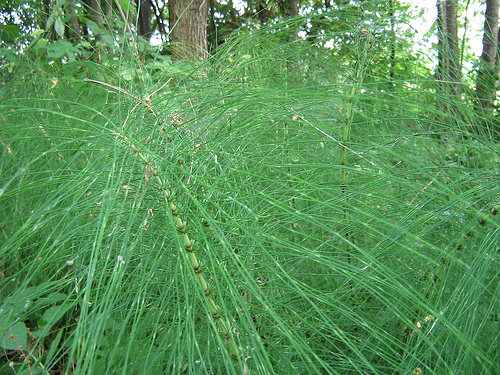Cola de Caballo – Giant Horsetail

Common Names: Horsetail, Giant Horsetail, Southern Giant Horsetail, Cola de Caballo, Equisetum giganteum, Equisetum, Common Horsetail
Latin Name: Equisetum giganteum
Origin: Asia, South America, North America
Short Introduction
The ideal conditions for Giant Horsetail to thrive are soils with moist, deep substrates, preferably along coastlines, around rivers in mountainous areas, and in humid jungles across Peru, Brazil, and Chile. In general, it requires a very humid environment. Under suitable conditions, it can reach heights of up to 3 meters. For regions such as the Czech Republic, there is currently no available literature describing the possibilities of cultivating Giant Horsetail at home. In countries with a similar latitude (but higher humidity), growers recommend moving these plants indoors during winter (typically stored in large containers). In this case, it’s important to water the plant regularly on a 15–20 day cycle each month. Some sources mention the option of outdoor cultivation during winter (provided temperatures do not drop below freezing). The plant enjoys direct sunlight, but will sometimes appreciate a shady spot to rest. During spring, frequent fertilization is recommended (using granulated or powdered forms, or even natural fertilizers).
Detailed Description
Cola de Caballo is a reservoir of minerals with remarkable potential to support both physical and mental wellbeing.
Botanical Information
Cola de Caballo, or Giant Horsetail, is among the largest horsetails in the world and also one of the oldest plant species on Earth. It typically reaches an average height of 2.5–5 meters, with most specimens growing to about 3 meters tall. The stem is very robust—some individuals may be up to 160 cm in diameter—and generally supports a large fan of slender branches. These branchlets are not further subdivided, but may end in spores.
Origin and Distribution
Giant Horsetail is native to regions of South and Central America. Its original habitat extended from today’s central Chile eastwards across the borders of Brazil and northwards up to around southern Mexico.
Usage / Dosage
Cola de Caballo—the local name for Equisetum giganteum—is a South American relative of the Common Horsetail known in temperate zones. The plant contains a very high concentration of minerals, especially silica, which lends itself well to therapeutic use. The mineral content helps support healthy skin, and improve hair and nail condition (promoting mineralization). When applied externally, it can aid in the healing of surface wounds. Studies have shown that a deficiency in minerals and silica may result in a higher incidence of dermatological issues such as fungal infections, hair loss, excessive dandruff, brittle nails, and more. Clinical tests have confirmed that Giant Horsetail displays reliable and statistically significant diuretic properties, which is why it’s included in diuretic herbal blends and recognized for its ability to support kidney and urinary system function.
Giant Horsetail is diuretic and has astringent effects. It shows a pronounced impact on inflammation of the urinary tract and may be recommended alongside other remedies or medicines. In folk medicine, it’s commonly used for painful urination, gallstones, chronic inflammation of the bladder and urethra. According to traditional healing, Giant Horsetail also positively affects prostate health in men and gynecological complaints in women.
The concentration of these active compounds also suggests that they may help maintain the correct structure and function of bones, joints, ligaments, and the entire musculoskeletal system. A lack of silica and calcium can predispose one to brittle bones and general weakness. The compounds in Giant Horsetail provide a refreshing effect for tired and sore bodies, increase overall resilience, and contribute to wellness when paired with healthy habits. Traditionally, it is recommended for colds, detoxification, and slowing down the aging process.
In tissue cultures, extracts from Giant Horsetail have shown to increase blood vessel elasticity, which suggests its ingredients may improve vascular health. With mild blood-thinning properties, they may contribute to cardiovascular system health. Silica in particular is believed to strengthen capillary walls and improve vascular flexibility, especially in cases of atherosclerosis. The plant’s compounds also help ease symptoms of atherosclerosis by modestly lowering cholesterol levels.
Another valuable use of Giant Horsetail in folk healing is for cleansing the intestines and disinfecting the internal environment of the stomach. In traditional medicine, it’s commonly used to help with digestive problems, including stomach ulcers. Similar disinfecting effects are expected when used as a mouthwash for canker sores and painful tooth inflammations. For centuries, Giant Horsetail has been used to alleviate respiratory issues and to address complications caused by tuberculosis and other respiratory diseases.
Active Compounds
Giant Horsetail boasts a high concentration of minerals—after incineration, the inorganic residue may account for up to 70% of its total mass. It contains silicic acid (up to 8% total content), pure silica, and other inorganic ions such as calcium, magnesium, iron, aluminum, and potassium. More complex constituents include alkaloids (palustrine, equisetonine), organic acids (including salicylic acid), flavonoids (quercetin, kaempferol), saponins (equisetonin), tannins (bitter, astringent taste, trace amounts), and phytosterols.
Traditional Dosage
For treating the urinary-genital tract, baths or decoctions using this herb are recommended, which can also be used for internal washing. For internal use: boil 1–3 g of the herb in 1 liter of boiling water, simmer gently for 5–10 minutes, then strain. The infusion should be golden in color with a mild, unobtrusive aroma. Drink one glass (approx. 250 ml) three times daily from this prepared solution.
